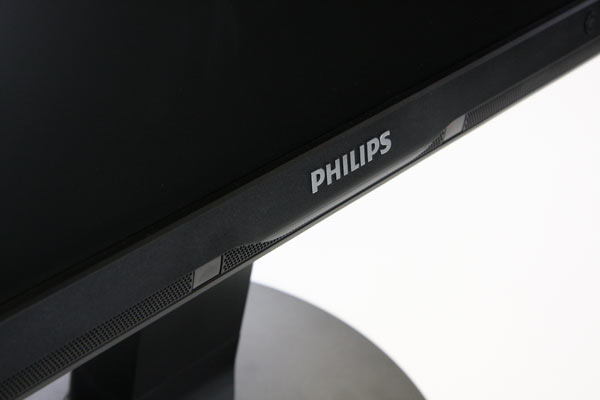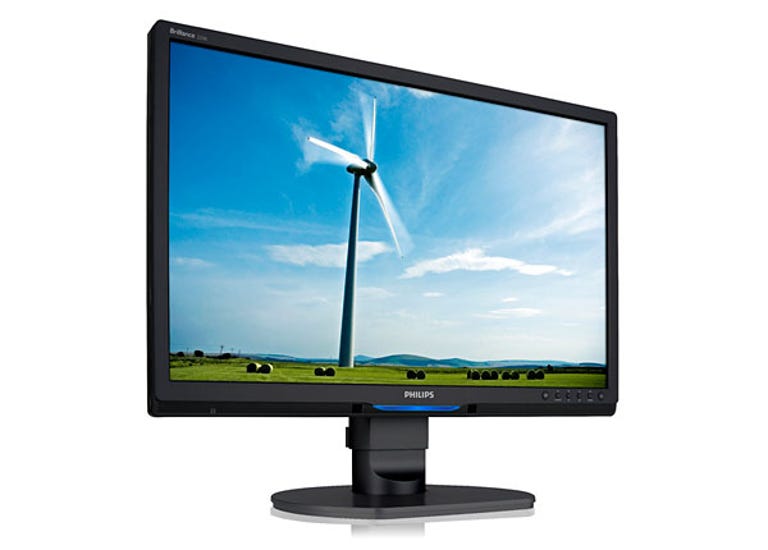 Why You Can Trust CNET
Why You Can Trust CNET Philips Brilliance 225B review: Philips Brilliance 225B
While its display quality is no greater or less than the norm, Philips' Brilliance 225B does one thing very well: saves power. Just don't use it for gaming.
Update: Due to additional gaming tests, the score for the Brilliance 225B has been revised since initial publication.
The Good
The Bad
The Bottom Line
In an age of glossy thin monitors, Philip's austere 22-inch, matte black screen harkens to the past, and is aimed purely at business.
That's not to say it's without charm — the matte screen means reduced glare and reflections, and the monitor's hero feature — the ability to dim the screen when the user walks away — is genuinely useful.
Philips calls it "PowerSensor", and it works through two infrared sensors mounted to the bottom of the panel. Once it detects no presence within a user-definable distance, the screen is dimmed; when a person returns, it resumes the usual brightness. Sadly, the level of dimming isn't user definable, nor can you simply tell the monitor to switch itself off, but any power saving is a bonus.

Two IR sensors at the bottom of the screen detect if a user is sitting in front or not, and dims the screen if no one is there. There is a blue power light directly under the Philips logo — thankfully, you can lower the brightness or turn it off altogether in the OSD. (Credit: Craig Simms/CBS Interactive)
| Size | 22 inches |
|---|---|
| Resolution | 1680x1050 |
| Aspect Ratio | 16:10 |
| Pixel pitch | 0.282 |
| Panel technology | TN |
| Viewing angles (10:1 contrast) | H: 170° V: 160° |
| Response time | 5ms G2G |
| Max vertical refresh | 75Hz |
| Connections | DVI, VGA, 3.5mm line in, headphone jack, 1x USB |
| Accessories | DVI, VGA, 3.5mm audio, power cables; HDMI > DVI adapter |
Philips offers greater adjustability than is usually given in this class of monitor, with the stand allowing height and swivel adjustments above the usual tilt. At its bottom height, the actual screen panel is 135mm from the ground, and can extend to 205mm.
The 225B has quite a decent height adjustment, although the action is not smooth, making it hard to be precise. (Credit: Craig Simms/CBS Interactive)
Cable management is handled by a bifurcated, curved and nooked piece of plastic at the back of the neck. While it looks deceptively unaccommodating, it happily took all the cables we could feasibly plug into the 225B at once.
Cable management at the back of the neck. (Credit: Craig Simms/CBS Interactive)
3.5mm audio in, power, DVI and VGA. (Credit: Craig Simms/CBS Interactive)
A single USB port is offered on the left-hand side. Most competitors either offer four, or none. A headphone jack can be found on the underside of the monitor. (Credit: Craig Simms/CBS Interactive)
A single 3.5mm audio line-in jack is provided, along with dual 1.5W speakers. As is typical of monitor speakers, performance is terrible, strangely lacking in clarity at the high end yet still hissy, with very little punch and lacking in bass.
Buttons and on-screen display (OSD)
The 225B's buttons are front mounted and have dual functions — the bottom icons representing what function will be accessed if they are pushed first, the top icons representing their functions in the OSD.
The 225B has front-mounted, easy-to-use buttons. (Credit: Craig Simms/CBS Interactive)
The only exclusion is the power button on the right, and the "SmartImage" button on the left, which cycles through Philips' image presets, labelled "Economy", "Entertainment", "Image viewing" and "Office work", each one adjusting brightness, contrast and sharpness. As is usual with image presets, they're awful, and we recommend leaving them off.
Philips' on-screen display is clean and easy to navigate. (Credit: Craig Simms/CBS Interactive)
Scaling options are limited to full screen ("widescreen") and 4:3.
Lagom.nl LCD tests
After calibrating to a target brightness of 140cd/m² with an X-Rite i1Display 2, Eye-One Match 3 and tweaking with HCFR, the Philips was run through the Lagom.nl LCD tests.
A slight banding was present in the gradient test, as was a slight purple tinge, a common display issue. All else was passed except the pixel walk 2b inversion test, which flickered. This isn't necessarily awful — most monitors fail one to two of the pixel walk tests.
| Image tests | |||||
|---|---|---|---|---|---|
| Contrast | Sharpness | Gamma | Black level | White saturation | Gradient |
| Pass | Pass | Pass | Pass | Pass | Slight banding, slight purple tinge |
| Inversion pixel walk tests | ||||||||||
|---|---|---|---|---|---|---|---|---|---|---|
| Test 1 | Test 2a | Test 2b | Test 3 | Test 4a | Test 4b | Test 5 | Test 6a | Test 6b | Test 7a | Test 7b |
| Pass | Pass | Slight flicker | Pass | Pass | Pass | Pass | Pass | Pass | Pass | Pass |
Input lag
Measured against a Samsung SyncMaster 975p CRT, and using a Canon 40D set to a shutter speed of 1/320, an average over 60 photographs were taken. The result came in as 12.7ms, just under one frame. The highest recorded value was 32ms.
Gaming performance
While usually we don't come across issues here and hence don't note it, the Philips showed a considerable amount of blurriness in Half Life 2: Episode 2 compared to what we're used to. We'd recommend it be kept for office uses only, which is its intended market anyway.
Colour accuracy
ΔE is the measurement of how far a measured colour deviates from its expected value, allowing us to determine the colour accuracy of a monitor. While a ΔE value of 1 is considered perceivable, as long as it's less than 3 the shift shouldn't be too obvious. HCFR was used to determine ΔE for the monitor.
Let's see how the 225B arrived in uncalibrated format.
| Measured levels | |
|---|---|
| Contrast ratio | 860:1 |
| Black level (cd/m²) | 0.35 |
| White level (cd/m²) | 301.01 |
| Gamma | 2.05 |
| Greyscale ΔE | ||||||||||
|---|---|---|---|---|---|---|---|---|---|---|
| 0% | 10% | 20% | 30% | 40% | 50% | 60% | 70% | 80% | 90% | 100% |
| 48.4 | 33.2 | 15.8 | 7.9 | 3.8 | 3.5 | 4.8 | 6.6 | 7.2 | 8.6 | 11.5 |
| Colour ΔE | |||||
|---|---|---|---|---|---|
| Red | Green | Blue | Yellow | Cyan | Magenta |
| 2.5 | 3.5 | 11.6 | 4.5 | 12.2 | 17.8 |
The uncalibrated CIE chart. The white triangle is the colour space of the monitor, the dark the sRGB gamut it's trying to match. Note the white dots all over the place, rather than being neatly along the black line — this shows our greyscale as out of whack. (Screenshot by CBS Interactive)
Not so crash hot. While full saturated red is acceptable and green is fairly close, the greyscale is all over the place and blue is pushing towards green. Let's see how good we can get it post calibration.
| Measured levels | |
|---|---|
| Contrast ratio | 713:1 |
| Black level (cd/m²) | 0.19 |
| White level (cd/m², target 140cd/m²) | 135.49 |
| Gamma (target 2.2) | 2.16 |
| Greyscale ΔE | ||||||||||
|---|---|---|---|---|---|---|---|---|---|---|
| 0% | 10% | 20% | 30% | 40% | 50% | 60% | 70% | 80% | 90% | 100% |
| 47.4 | 10.3 | 1.7 | 1.4 | 0.6 | 0.8 | 1.1 | 0.3 | 1.0 | 0.5 | 0.3 |
| Colour ΔE | |||||
|---|---|---|---|---|---|
| Red | Green | Blue | Yellow | Cyan | Magenta |
| 3.1 | 5.8 | 8.4 | 7.1 | 5.3 | 9.7 |
The calibrated CIE chart (Screenshot by CBS Interactive)
Much better. Things now only get bent out of shape towards the darker end of the greyscale; however, it's at the cost of less accurate fully saturated red, green and yellow values. As with most consumer monitors, the 225B does not offer advanced colour management, and so this is as good as it gets.
Viewing angles
Viewing angles were taken with a Canon 40D in spot metering mode, with only shutter time adjusted to obtain a good exposure.
As you can see, the typical TN panel inversion from the bottom of the panel is prevalent. This isn't so relevant, unless you're the type who looks at your screen from the floor. Nonetheless, we wouldn't recommend any TN panel for shared movie viewing. (Credit: Craig Simms/CBS Interactive)
Backlight uniformity
Backlight uniformity was measured by placing HCFR into free measure mode, displaying a completely white image and recording the brightness along a 5x3 grid on the screen. This should be considered a guide only, as backlight uniformity is likely to change from unit to unit.
The Philips screen is brighter at the top and to the right, and darker at the bottom and the left. (Credit: Craig Simms/CBS Interactive)
Despite the seemingly big shift, this isn't too bad for a non-colour-critical monitor.
Light bleed
With all the lights turned off and a black image shown, there was obvious light bleed at the top, particularly coming from the top left.
It's important to note that the effects of light bleed will likely change from monitor to monitor, regardless of make.
Power consumption
We measured power consumption using a Jaycar mains digital power meter. It's important to note here that due to limitations of the meter, measurements are limited to values 1W and greater, and are reported in 1W increments.
For all measurements, screen brightness and contrast were set to 100%, and a test image displayed.
| Juice Box |  |
|---|---|
| Maximum power draw | 23W |
| "PowerSense" max draw | 17W |
| Power-saving mode | <1W< td=""> |
| Off | <1W< td=""> |
This is excellent — most monitors come in significantly above this.
Philips offers a three-year, on-site warranty with the 225B. As seems to be common though, the amount of failed pixels required to make a warranty claim are a little voodoo.
| Pixel faults | "Acceptable" level of defects |
|---|---|
| Bright pixels | Three single subpixels (red, green or blue dot) Two adjacent subpixels (cyan, yellow, magenta dot) No white pixels Distance between bright dot defects > 15mm |
| Dark pixels | Five dark subpixels No more than two adjacent subpixels Distance between bright dot defects > 15mm |
Never fear if you purchase a unit that already has dead pixels though, as Philips offers a DOA period of 14 days from purchase where it will swap the unit for a new one.
While its display quality is no greater or less than the norm, Philips' Brilliance 225B does one thing very well: saves power. It's one of the lowest consumers we've seen, and this along with the added height adjustment makes it a compelling buy for the business customer.


